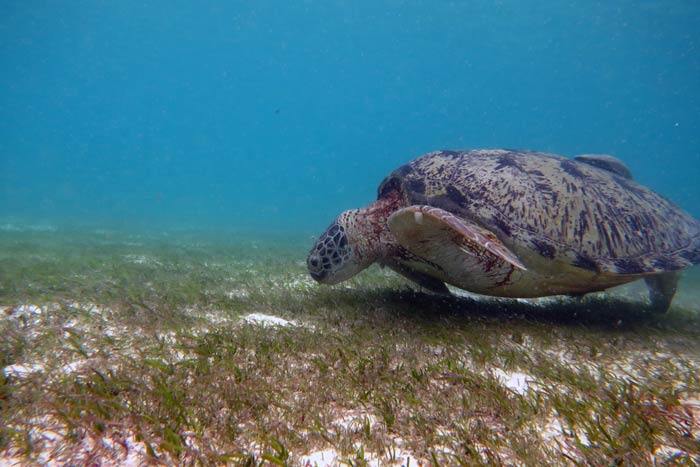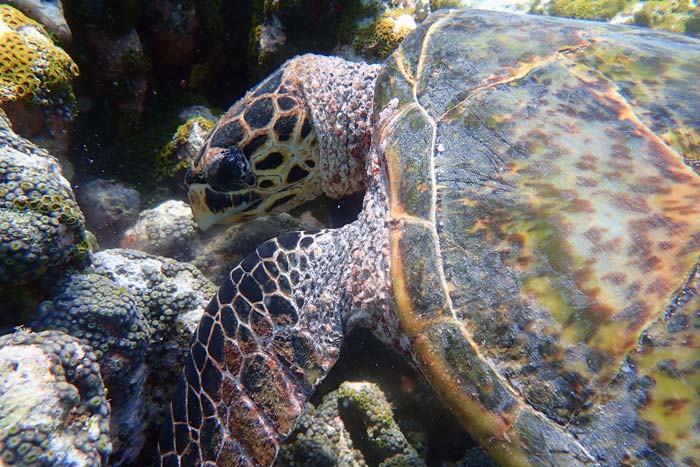Sea turtles have many recognized roles in the evolution and maintenance of the structure and dynamics of marine ecosystems; they are an integral part of the interspecific interactions in marine ecosystems as prey, consumer, competitor, and host. They also serve as significant conduits of nutrient and energy transfer within and among ecosystems; and can also substantially modify the physical structure of marine ecosystems.
Sea turtles are an important part of the planet’s food web and play a vital role in maintaining the health of the world’s oceans. They regulate a variety of other organisms simply through eating them. For example, green turtles mainly feed on seagrass. By grazing on seagrass meadows, they prevent the grass from growing too long and suffocating on itself. Nice and healthy seagrass beds again perform a multitude of so-called ecosystem functions: they are a nursery ground for many marine species and additionally are an important carbon sink and oxygen provider in the ocean.
Another example are hawksbill turtles, who are mostly focused on eating sponges. Their sponge consumption is very important for a healthy coral reef by keeping the fast-growing sponges at bay and giving slower growing corals the chance to grow. Coral reefs are thought to be the most diverse ecosystem on the planet, providing habitats and shelter for thousands of marine organisms. Many fish spawn on the coral reefs and juvenile fish spend time there before heading out to deeper waters when they mature. Coral reefs also protect coastlines from wave action and storms and are an important revenue generator for many nations through tourism.
Leatherbacks eat jellyfish. Keeping the jellyfish population in check is important. Jellyfish prey on fish eggs and larvae and too many jellyfish means fewer fish.
Loggerheads feed on hard-shelled prey, such as crustaceans. By breaking up these shells, they increase the rate at which the shells disintegrate and, as a result, increase the rate of nutrient recycling in the ocean bottom ecosystems.
Sea turtles also provide habitat for many marine organisms! Barnacles, algae and small creatures called epibionts attach themselves to the turtle and by carrying these around, the sea turtles provide a food source for fish and shrimp. In fact, some fish species obtain their diet strictly from epibionts found on sea turtles.
Apart from that, sea turtles provide an important food source for other organisms, especially in their early life stages. Ants, crabs, rats, raccoons, foxes, coyotes, feral cats, dogs, mongoose and vultures are known to dig up unhatched turtle eggs; the eggs are a nutrient-rich source of food. Juvenile turtles are a food source for various sea birds, fish and invertebrates. Adult sea turtles are preyed upon by sharks and killer whales.
Unhatched eggs and empty eggshells remaining inside nests on the beaches are a fertilizer for beach vegetation – they provide nutrition for plant growth with helps stabilize the shoreline as well as provide food for a variety of plant eating animals.
Because sea turtles can migrate huge distances, they also play an important role in generating and maintaining diversity throughout the world’s oceans by transporting the organisms that live on them to and from reefs, seagrass beds and the open ocean.


References:
- Bjorndal, K. A., & Jackson, J. B. (2002). 10 Roles of sea turtles in marine ecosystems: reconstructing the past. The biology of sea turtles, 2, 259.
- León, Y. M., & Bjorndal, K. A. (2002). Selective feeding in the hawksbill turtle, an important predator in coral reef ecosystems. Marine Ecology Progress Series, 245, 249-258.

